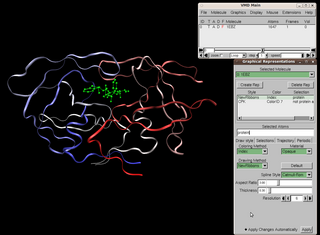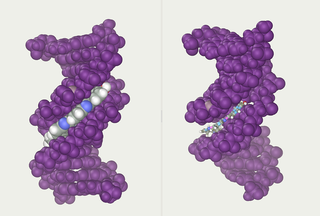Related Research Articles

Computational chemistry is a branch of chemistry that uses computer simulation to assist in solving chemical problems. It uses methods of theoretical chemistry, incorporated into computer programs, to calculate the structures and properties of molecules, groups of molecules, and solids. The importance of this subject stems from the fact that, with the exception of some relatively recent findings related to the hydrogen molecular ion, achieving an accurate quantum mechanical depiction of chemical systems analytically, or in a closed form, is not feasible. The complexity inherent in many-body problem exacerbates the challenge of providing detailed descriptions in quantum mechanical systems. While computational results normally complement the information obtained by chemical experiments, it can in some cases predict unobserved chemical phenomena.
GROMACS is a molecular dynamics package mainly designed for simulations of proteins, lipids, and nucleic acids. It was originally developed in the Biophysical Chemistry department of University of Groningen, and is now maintained by contributors in universities and research centers worldwide. GROMACS is one of the fastest and most popular software packages available, and can run on central processing units (CPUs) and graphics processing units (GPUs). It is free, open-source software released under the GNU General Public License (GPL), and starting with version 4.6, the GNU Lesser General Public License (LGPL).

Assisted Model Building with Energy Refinement (AMBER) is a family of force fields for molecular dynamics of biomolecules originally developed by Peter Kollman's group at the University of California, San Francisco.
Chemistry at Harvard Macromolecular Mechanics (CHARMM) is the name of a widely used set of force fields for molecular dynamics, and the name for the molecular dynamics simulation and analysis computer software package associated with them. The CHARMM Development Project involves a worldwide network of developers working with Martin Karplus and his group at Harvard to develop and maintain the CHARMM program. Licenses for this software are available, for a fee, to people and groups working in academia.

Molecular mechanics uses classical mechanics to model molecular systems. The Born–Oppenheimer approximation is assumed valid and the potential energy of all systems is calculated as a function of the nuclear coordinates using force fields. Molecular mechanics can be used to study molecule systems ranging in size and complexity from small to large biological systems or material assemblies with many thousands to millions of atoms.

Visual Molecular Dynamics (VMD) is a molecular modelling and visualization computer program. VMD is developed mainly as a tool to view and analyze the results of molecular dynamics simulations. It also includes tools for working with volumetric data, sequence data, and arbitrary graphics objects. Molecular scenes can be exported to external rendering tools such as POV-Ray, RenderMan, Tachyon, Virtual Reality Modeling Language (VRML), and many others. Users can run their own Tcl and Python scripts within VMD as it includes embedded Tcl and Python interpreters. VMD runs on Unix, Apple Mac macOS, and Microsoft Windows. VMD is available to non-commercial users under a distribution-specific license which permits both use of the program and modification of its source code, at no charge.

Molecular modelling encompasses all methods, theoretical and computational, used to model or mimic the behaviour of molecules. The methods are used in the fields of computational chemistry, drug design, computational biology and materials science to study molecular systems ranging from small chemical systems to large biological molecules and material assemblies. The simplest calculations can be performed by hand, but inevitably computers are required to perform molecular modelling of any reasonably sized system. The common feature of molecular modelling methods is the atomistic level description of the molecular systems. This may include treating atoms as the smallest individual unit, or explicitly modelling protons and neutrons with its quarks, anti-quarks and gluons and electrons with its photons.

In the context of chemistry and molecular modelling, a force field is a computational method that is used to estimate the forces between atoms within molecules and also between molecules. More precisely, the force field refers to the functional form and parameter sets used to calculate the potential energy of a system of atoms or coarse-grained particles in molecular mechanics, molecular dynamics, or Monte Carlo simulations. The parameters for a chosen energy function may be derived from experiments in physics and chemistry, calculations in quantum mechanics, or both. Force fields are interatomic potentials and utilize the same concept as force fields in classical physics, with the difference that the force field parameters in chemistry describe the energy landscape, from which the acting forces on every particle are derived as a gradient of the potential energy with respect to the particle coordinates.
This is a list of computer programs that are predominantly used for molecular mechanics calculations.
Molecular design software is notable software for molecular modeling, that provides special support for developing molecular models de novo.

Molecular modeling on GPU is the technique of using a graphics processing unit (GPU) for molecular simulations.

Molecular Dynamics of Mixtures (MDynaMix) is a computer software package for general purpose molecular dynamics to simulate mixtures of molecules, interacting by AMBER- and CHARMM-like force fields in periodic boundary conditions. Algorithms are included for NVE, NVT, NPT, anisotropic NPT ensembles, and Ewald summation to treat electrostatic interactions. The code was written in a mix of Fortran 77 and 90. The package runs on Unix and Unix-like (Linux) workstations, clusters of workstations, and on Windows in sequential mode.

CP2K is a freely available (GPL) quantum chemistry and solid state physics program package, written in Fortran 2008, to perform atomistic simulations of solid state, liquid, molecular, periodic, material, crystal, and biological systems. It provides a general framework for different methods: density functional theory (DFT) using a mixed Gaussian and plane waves approach (GPW) via LDA, GGA, MP2, or RPA levels of theory, classical pair and many-body potentials, semi-empirical and tight-binding Hamiltonians, as well as Quantum Mechanics/Molecular Mechanics (QM/MM) hybrid schemes relying on the Gaussian Expansion of the Electrostatic Potential (GEEP). The Gaussian and Augmented Plane Waves method (GAPW) as an extension of the GPW method allows for all-electron calculations. CP2K can do simulations of molecular dynamics, metadynamics, Monte Carlo, Ehrenfest dynamics, vibrational analysis, core level spectroscopy, energy minimization, and transition state optimization using NEB or dimer method.
This is a list of notable computer programs that are used for nucleic acids simulations.

Abalone is a general purpose molecular dynamics and molecular graphics program for simulations of bio-molecules in a periodic boundary conditions in explicit or in implicit water models. Mainly designed to simulate the protein folding and DNA-ligand complexes in AMBER force field.
MacroModel is a computer program for molecular modelling of organic compounds and biopolymers. It features various chemistry force fields, plus energy minimizing algorithms, to predict geometry and relative conformational energies of molecules. MacroModel is maintained by Schrödinger, LLC.
Massively Parallel Monte Carlo (MPMC) is a Monte Carlo method package primarily designed to simulate liquids, molecular interfaces, and functionalized nanoscale materials. It was developed originally by Jon Belof and is now maintained by a group of researchers in the Department of Chemistry and SMMARTT Materials Research Center at the University of South Florida. MPMC has been applied to the scientific research challenges of nanomaterials for clean energy, carbon sequestration, and molecular detection. Developed to run efficiently on the most powerful supercomputing platforms, MPMC can scale to extremely large numbers of CPUs or GPUs. Since 2012, MPMC has been released as an open-source software project under the GNU General Public License (GPL) version 3, and the repository is hosted on GitHub.
Qbox is an open-source software package for atomic-scale simulations of molecules, liquids and solids. It implements first principles molecular dynamics, a simulation method in which inter-atomic forces are derived from quantum mechanics. Qbox is released under a GNU General Public License (GPL) with documentation provided at http://qboxcode.org. It is available as a FreeBSD port.
References
- Lagardère, Louis; Jolly, Luc-Henri; Lipparini, Filippo; Aviat, Félix; Stamm, Benjamin; Jing, Zhifeng F.; Harger, Matthew; Torabifard, Hedieh; Cisneros, Andrés; Schnieders, Michael; Gresh, Nohad; Maday, Yvon; Ren, Pengyu; Ponder, Jay; Piquemal, Jean-Philip (2018). "Tinker-HP : Accelerating Molecular Dynamics Simulations of Large Complex Systems with Advanced Point Dipole Polarizable Force Fields using GPUs and Multi-GPUs systems". Chemical Science. 9 (4): 956–972. doi:10.1039/C7SC04531J. PMC 5909332 . PMID 29732110.
- Adjoua, Olivier; Lagardère, Louis; Jolly, Luc-Henri; Durocher, Arnaud; Wang, Zhi; Very, Thibaut F.; Dupays, Isabelle; Jaffrelot Inizan, Theo; Célerse, Frédéric; Ren, Pengyu; Ponder, Jay; Piquemal, Jean-Philip (2021). "Tinker-HP: a Massively Parallel Molecular Dynamics Package for Multiscale Simulations of Large Complex Systems with Advanced Point Dipole Polarizable Force Fields". Journal of Chemical Theory and Computation. 17 (4): 2034–2053. doi:10.1021/acs.jctc.0c01164. PMC 7654869 . PMID 33173801.
- Rackers, Joshua A.; Wang, Zhi; Lu, Chao; Maury, Marie L.; Lagardère, Louis; Schnieders, Michael; Piquemal, Jean-Philip; Ren, Pengyu; Ponder, Jay (2018). "Tinker 8: Software Tools for Molecular Design". Journal of Chemical Theory and Computation. 14 (10): 5273–5289. doi:10.1021/acs.jctc.8b00529. PMC 6335969 . PMID 30176213.
- Harger, Matthew; Li, Daniel; Wang, Zhi; Dalby, Kevin; Lagardère, Louis; Piquemal, Jean-Philip; Ponder, Jay W.; Ren, Pengyu (2017). "Tinker-OpenMM : Absolute and Relative Alchemical Free Energies using AMOEBA on GPUs". Journal of Computational Chemistry. 38 (23): 2047–2055. doi:10.1002/jcc.24853. PMC 5539969 . PMID 28600826.
- Ren, Pengyu; Ponder, Jay W. (2003). "Polarizable Atomic Multipole Water Model for Molecular Mechanics Simulation". The Journal of Physical Chemistry B. 107 (24): 5933–5947. doi:10.1021/jp027815+.
- Pappu, Rohit V.; Hart, Reece K.; Ponder, Jay W. (1998). "Analysis and Application of Potential Energy Smoothing and Search Methods for Global Optimization". The Journal of Physical Chemistry B. 102 (48): 9725. doi:10.1021/jp982255t.
- Kong, Yong; Ponder, Jay W. (1997). "Calculation of the reaction field due to off-center point multipoles". The Journal of Chemical Physics. 107 (2): 481. Bibcode:1997JChPh.107..481K. doi: 10.1063/1.474409 .
- Dudek, Michael J.; Ponder, Jay W. (1995). "Accurate modeling of the intramolecular electrostatic energy of proteins". Journal of Computational Chemistry. 16 (7): 791. CiteSeerX 10.1.1.502.6823 . doi:10.1002/jcc.540160702. S2CID 15899639.
- Kundrot, Craig E.; Ponder, Jay W.; Richards, Frederic M. (1991). "Algorithms for calculating excluded volume and its derivatives as a function of molecular conformation and their use in energy minimization". Journal of Computational Chemistry. 12 (3): 402. CiteSeerX 10.1.1.511.419 . doi:10.1002/jcc.540120314. S2CID 53518520.
- Ponder, Jay W.; Richards, Frederic M. (1987). "An efficient newton-like method for molecular mechanics energy minimization of large molecules". Journal of Computational Chemistry. 8 (7): 1016. doi:10.1002/jcc.540080710. S2CID 11607431.